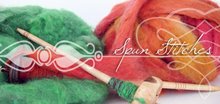I really regret not taking a 'before' picture of the wool. I don't know why I didn't think of it. But let me tell you, it was pretty messy. Well, it was on a sheep..er goat.. and hadn't been washed before, so what's one to expect? :D
Well, I drew a nice hot bath for the hair. I put in some laundry soap. It's the only thing I really had on hand that was meant for washing fibers so I just went with it. I've heard a lot of recommendations for Power Scour, so next time I'm thinking I'll give that a try.
I made the water fairly hot and just let the fibers soak for almost an hour until the water was relatively cool. See how dirty that water is? Yeah...didn't smell any better.

As I begun to pick out the V.M. (Vegetable matter) I found yellow gunk in the wool. I'm thinking it was Lanolin. The consistency is the same as is the color. Lanolin..as seen below..is a yellow oil from sheep's wool. It's a water resistant oil and really beneficial in beauty products. This particular batch I used to make a home made baby bottom balm for diaper rash. It worked amazingly well. Made with cocoa butter and vitamin E, the lanolin repelled the wetness while the cocoa butter moisturized and the vitamin E healed the skin. If you want some of it in bulk I HIGHLY recommend these people!
 Ok, back on topic.
Ok, back on topic.Turn forward about 3 1/2 hours.
Here's a nice pile of the finished and picked fiber. Still some dirt and stuff...but not a lot. Majority of it came out when it dried. Normally wool is supposed to dry quickly...but this batch took a little over 3 days to dry! And yes I was shifting it and putting it in ventelated places.

Like the bathtub with the vent on. I even put it in front of the window to dry. The locks just retained the water, so I learned about a little virtue called patience. Odd I never waited around to learn about it before. :D

DRY! That's my handy dandy flick carder. I did the normal flick carding on a few locks. You know, holding the lock's tip, combing downwards on the fibers to open them up. I found out that it didn't do much, they weren't opening up as they should be. I do need to invest in hand carders...but I made do with what I had.

Here's some of the locks after being flicked a few times. Some of the locks had mats, which made it really hard to just flick card. So I ended up combing it a bit. Not sure if that's good, but I want to spin this wool and not have huge lumps in it.

After a bit of preparation, the wool came out VERY silky and fluffy. It was beautiful! This shot doesn't do it justice. It has a very shiny gloss to it and it's utterly soft.

Word to the wise. Don't use pants as a flick card backing. You won't have much pants left.

And here's some of the finished yarn drying in the bathroom. See that lock? It's pretty, but it ended up being very "novelty yarn-ish". I did another batch of spinning and it turned out much better, but my real problem is HOW to spin it. If it were in a roving, I'd spin it lace weight no problem. But being little batches of fluff...it's terribly difficult. It's almost like spinning poly fill.

After getting the hang of it, some of the yarn became thinner and less hairy, with no locks of hair poking out. (I noticed that the locks actually created "weak" spots in the yarn and it end up drifting apart while being knitted) I'm thinking that this yarn will probably have to be blended with another fiber.
If anyone can let me know how to properly spin this without tearing my hair out (I'm sure I'd spin that too and make a hat) please let me know! :D








No comments:
Post a Comment